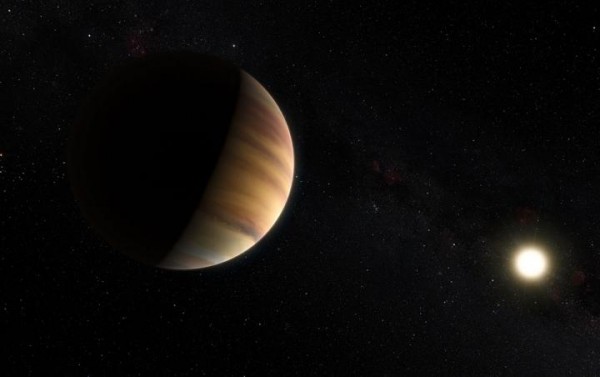First Visible Light Seen from Alien Exoplanet
| Marco Foronda | | Apr 23, 2015 06:12 AM EDT |
(Photo : ESO/M. Kornmesser/Nick Risinger) Artist's view shows the hot Jupiter exoplanet 51 Pegasi b, sometimes referred to as Bellerophon, which orbits a star about 50 light-years from Earth.
For the first time, astronomers have detected a visible-light spectrum directly from an exoplanet.
The European Southern Observatory's (ESO) La Silla Observatory in Chile made the first-ever direct detection of the spectrum of visible light reflected off an exoplanet using the HARPS planet-hunting machine.
Like Us on Facebook
These observations also revealed new properties of this famous object, the first exoplanet ever discovered around a normal star: 51 Pegasi b. The result promises an exciting future for this technique, particularly with the advent of next generation instruments such as ESPRESSO on the Very Large Telescope (VLT) and future telescopes such as the E-ELT.
The exoplanet was discovered in 1995 and is the first confirmed exoplanet found orbiting an ordinary star like the Sun.
It's also regarded as the archetypal hot Jupiter -- a class of planets now known to be relatively commonplace, and similar in size and mass to Jupiter but that orbit much closer to their parent stars. The exoplanet 51 Pegasi b lies some 50 light years from Earth in the constellation Pegasus.
The most-widely used method to examine an exoplanet's atmosphere is to observe the host star's spectrum as it's filtered through the planet's atmosphere during transit, a technique known as transmission spectroscopy. The new technique used with 51 Pegasi b doesn't depend on finding a planetary transit, however, and so can potentially be used to study many more exoplanets.
"This type of detection technique is of great scientific importance, as it allows us to measure the planet's real mass and orbital inclination, which is essential to more fully understand the system. It also allows us to estimate the planet's reflectivity, or albedo, which can be used to infer the composition of both the planet's surface and atmosphere," said lead author Jorge Martins from the Instituto de Astrofisica e Ciencias do Espaco (IA) and the Universidade do Porto, in Portugal, who is currently a PhD student at ESO in Chile.
The host star's spectrum is used as a template to guide a search for a similar signature of light expected to be reflected off the planet as it describes its orbit. This is a difficult task as planets are dim in comparison to their parent stars. The signal from the planet is also easily swamped by other tiny effects and sources of noise.
This research was published in the journal Astronomy & Astrophysics.
TagsFirst Visible Light Seen from Alien Exoplanet, visible light, alien exoplanet, exoplanet, 51 Pegasi b, Jupiter, NASA, very large telescope, space exploration, ESO, E-ELT
©2015 Chinatopix All rights reserved. Do not reproduce without permission
EDITOR'S PICKS
-

Did the Trump administration just announce plans for a trade war with ‘hostile’ China and Russia?
-

US Senate passes Taiwan travel bill slammed by China
-

As Yan Sihong’s family grieves, here are other Chinese students who went missing abroad. Some have never been found
-

Beijing blasts Western critics who ‘smear China’ with the term sharp power
-

China Envoy Seeks to Defuse Tensions With U.S. as a Trade War Brews
-

Singapore's Deputy PM Provides Bitcoin Vote of Confidence Amid China's Blanket Bans
-

China warns investors over risks in overseas virtual currency trading
-

Chinese government most trustworthy: survey
-

Kashima Antlers On Course For Back-To-Back Titles
MOST POPULAR
LATEST NEWS
Zhou Yongkang: China's Former Security Chief Sentenced to Life in Prison

China's former Chief of the Ministry of Public Security, Zhou Yongkang, has been given a life sentence after he was found guilty of abusing his office, bribery and deliberately ... Full Article
TRENDING STORY

China Pork Prices Expected to Stabilize As The Supplies Recover

Elephone P9000 Smartphone is now on Sale on Amazon India

There's a Big Chance Cliffhangers Won't Still Be Resolved When Grey's Anatomy Season 13 Returns

Supreme Court Ruled on Samsung vs Apple Dispute for Patent Infringement

Microsoft Surface Pro 5 Rumors and Release Date: What is the Latest?










